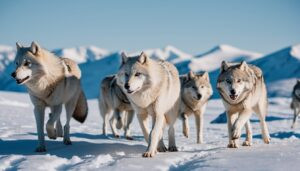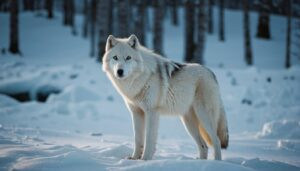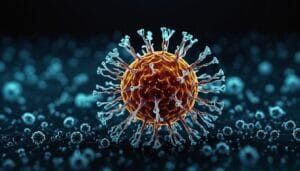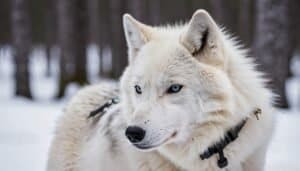Introduction
Isolated Arctic wolf populations face unique genetic challenges that influence their long-term survival and adaptability
Geographic barriers, small population sizes, and limited gene flow contribute to genetic drift and inbreeding, which can reduce genetic diversity and increase vulnerability to diseases and environmental changes
However, isolation can also drive local adaptations, offering insights into evolutionary processes. This article explores the genetic implications of isolation in Arctic wolves, highlighting risks, potential benefits, and conservation strategies to ensure their genetic health in a changing Arctic
Understanding the Genetics of Isolated Arctic Wolf Populations
Arctic wolf populations that are geographically or reproductively isolated face significant genetic challenges. These small, isolated groups are subject to genetic drift and inbreeding, which can reduce genetic diversity over time
Understanding these genetic processes is essential for assessing the health and adaptability of Arctic wolves in an ever-changing environment
The Role of Genetic Drift in Small Populations
Genetic drift refers to random changes in allele frequencies within a population, often having a pronounced effect in small, isolated groups. In Arctic wolves, genetic drift can lead to the loss of rare alleles, reducing genetic variability and limiting the pack’s ability to adapt to environmental changes
Walker (2020) highlighted that genetic drift becomes more pronounced when populations remain isolated over multiple generations. For Arctic wolves, geographic barriers such as mountain ranges or ice fields restrict gene flow, exacerbating the effects of drift
This lack of genetic exchange increases the risk of genetic bottlenecks, where a sharp reduction in population size further narrows genetic diversity
Impacts of Inbreeding on Population Health
Inbreeding occurs when closely related individuals mate, leading to an increased likelihood of offspring inheriting harmful recessive alleles. In Arctic wolves, inbreeding can manifest as reduced fertility, lower pup survival rates, and increased susceptibility to diseases
Reed and Spencer (2019) found that inbreeding depression is a significant concern for small Arctic wolf populations
Inbreeding may reduce the vigor and reproductive success of a pack, compounding the challenges of living in a harsh environment. These effects can destabilize pack dynamics and reduce the long-term viability of isolated groups
How Genetic Diversity Influences Survival and Adaptation
Genetic diversity is a critical factor in the survival of any species, providing the raw material for adaptation to environmental changes
In Arctic wolves, higher genetic diversity is linked to greater resilience against diseases, more robust reproduction, and the ability to exploit diverse ecological niches
Hanson et al. (2021) emphasized that genetic diversity acts as a buffer against environmental stressors, such as shifts in prey availability or climate conditions. In isolated populations, however, reduced diversity limits this adaptability, leaving wolves more vulnerable to sudden or extreme changes
Conservation strategies that promote genetic diversity are therefore essential for maintaining the health and survival of Arctic wolf populations
Risks and Evolutionary Implications of Isolation
Isolation poses both risks and evolutionary opportunities for Arctic wolf populations. While it can lead to reduced genetic health, it may also drive local adaptations that help wolves survive in specific environments
Balancing these risks and benefits is key to understanding the long-term implications of isolation
Vulnerability to Diseases in Isolated Populations
One of the most immediate risks of genetic isolation is increased susceptibility to diseases. Low genetic diversity reduces the range of immune system responses available within a population, making isolated Arctic wolf packs more vulnerable to outbreaks of infectious diseases
For example, diseases such as canine distemper or parvovirus could spread rapidly through a genetically uniform population, with devastating consequences
Green (2022) highlighted that isolated populations are less likely to recover from disease outbreaks due to their limited reproductive base. In some cases, a single outbreak could cause localized extinction, especially in smaller packs
This vulnerability underscores the importance of maintaining genetic diversity to bolster disease resistance
Genetic Bottlenecks and Long-Term Population Viability
Genetic bottlenecks occur when a population experiences a significant reduction in size, leading to the loss of genetic variation
For Arctic wolves, bottlenecks are often triggered by environmental pressures, such as prey scarcity or extreme weather events, compounded by their geographic isolation
Johnson et al. (2018) noted that genetic bottlenecks can have long-term effects on Arctic wolf populations, including reduced adaptability to environmental changes and increased risk of inbreeding
These bottlenecks not only threaten the survival of individual packs but also limit the overall genetic health of the species, particularly in regions with small, fragmented populations
Potential for Divergence and Local Adaptations
Despite the risks, isolation can also drive local adaptations, allowing Arctic wolves to evolve traits that improve their survival in specific environments
Over time, isolated populations may develop unique characteristics, such as specialized hunting strategies or physiological changes to cope with extreme cold or limited prey
Walker (2020) observed evidence of genetic divergence in some isolated Arctic wolf populations, suggesting that isolation may lead to the emergence of distinct subpopulations. While this process can enhance survival in the short term, it also risks reducing the genetic exchange necessary for maintaining the overall resilience of the species
Isolation is a double-edged sword for Arctic wolves, presenting both challenges and opportunities
Addressing the risks of disease and bottlenecks while preserving the potential for local adaptations requires careful management and conservation efforts tailored to the unique needs of isolated populations
Conservation Strategies for Genetic Health
To ensure the long-term survival of isolated Arctic wolf populations, conservation efforts must address the genetic challenges posed by isolation
Strategies that promote genetic diversity, monitor population health, and mitigate the risks of inbreeding are essential for maintaining the viability of these apex predators
Enhancing Gene Flow Between Isolated Populations
Facilitating gene flow between isolated Arctic wolf populations is a critical strategy for preserving genetic diversity. Wildlife corridors, which connect fragmented habitats, can enable wolves to move between regions, reducing the effects of genetic drift and inbreeding
Walker (2020) highlighted that even occasional movement of individuals between isolated packs can have a significant impact on genetic health. Reintroducing wolves from other populations into isolated areas is another approach, though it must be done carefully to avoid disrupting existing social structures
Geographic and environmental challenges in the Arctic make implementing these solutions difficult. However, mapping critical movement pathways and targeting conservation efforts in areas where connectivity is most feasible can maximize their effectiveness
Monitoring Genetic Diversity in Arctic Wolves
Regular genetic monitoring is essential for identifying populations at risk of inbreeding or genetic bottlenecks
Advances in genetic sequencing technology allow researchers to assess the genetic makeup of Arctic wolf populations, track changes over time, and detect warning signs of reduced diversity
Hanson et al. (2021) emphasized the importance of integrating genetic monitoring into broader wildlife conservation programs
Collecting genetic samples through non-invasive methods, such as analyzing scat or fur, provides valuable data without disturbing the wolves. Monitoring efforts can inform conservation decisions and prioritize populations that require immediate intervention
Mitigating the Risks of Isolation Through Policy and Management
Policy and management play a crucial role in addressing the genetic implications of isolation. Designating protected areas that encompass large, connected habitats reduces habitat fragmentation and supports gene flow
Additionally, implementing policies that limit industrial activities, such as mining or Arctic shipping, can minimize disruptions to wolf territories
Johnson et al. (2018) highlighted the importance of involving local communities and Indigenous knowledge in conservation planning. These partnerships ensure that conservation strategies align with ecological and cultural priorities, fostering long-term support for Arctic wolf preservation
International collaboration is also essential, as Arctic wolves inhabit multiple countries with shared ecosystems. Transboundary conservation initiatives, such as the Arctic Council’s biodiversity programs, provide a framework for coordinating efforts to maintain genetic health across the species’ range
Through these strategies, conservationists can address the genetic challenges of isolation while supporting the ecological resilience of Arctic wolf populations
By enhancing connectivity, monitoring diversity, and implementing effective policies, we can safeguard the genetic health of these iconic predators for generations to come
Conclusion
Isolation in Arctic wolf populations presents significant genetic challenges, including increased risks of inbreeding, genetic drift, and reduced adaptability
While these factors threaten the long-term viability of isolated packs, they also create opportunities for local adaptations that can enhance survival in specific environments. Balancing these risks and opportunities is essential for effective conservation planning
Strategies such as enhancing gene flow through wildlife corridors, genetic monitoring, and creating protected areas are critical for maintaining genetic diversity. Collaborative efforts involving scientists, policymakers, and Indigenous communities are necessary to ensure these strategies are implemented effectively
The genetic health of Arctic wolves is intricately tied to their environment, requiring conservation approaches that address both ecological and genetic factors. By prioritizing connectivity, monitoring, and adaptive management, we can help Arctic wolves thrive despite the challenges of isolation in an ever-changing Arctic










